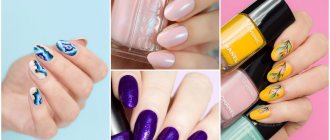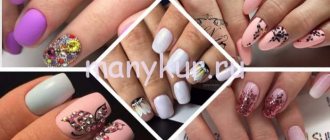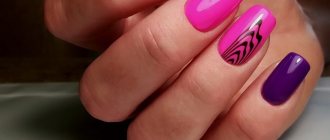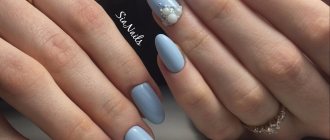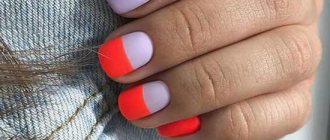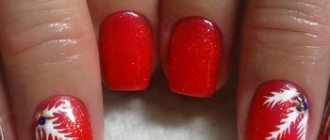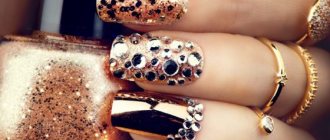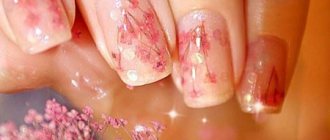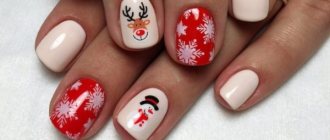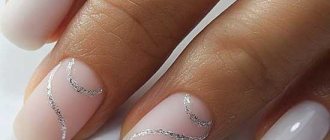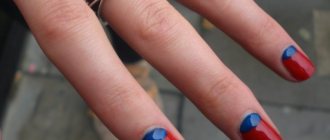Nail art can be called a free flight of fantasy, which does not obey any rules, as it should be in any form of creativity, even when it comes to drawings on nails. However, if the manicure should become a detail of the image that harmoniously complements it, you will still have to take into account some nuances: style, technique, color combinations. In this material we take a closer look at the rules for combining colors in manicure. We will talk about both a combination of two colors within one design, and a three-color manicure.
© paintboxnails
Rules for combining colors in manicure
Recommendations for color combinations apply not only to nail design, but also to the choice of clothing, makeup products and other items to which the laws of color apply. Those who want to act not by instinct, but by science, will have to study the classification of combinations. It includes monochromatic, achromatic, complementary and others.
1
Monochromatic combination
Monochromatic combinations are based on the principle of selecting several shades of the same color.
- So, for example, you can combine in a manicure a pastel blue with a milky white base, a more saturated, but at the same time delicate sky blue, as well as a catchy sea wave color or, perhaps, “electric” blue.
© GettyImages
It would seem that in this case the result will always look beautiful. However, even within the same color scheme you cannot combine shades blindly. A bright azure color will not harmonize very well with blue, which has a slight admixture of purple. It is important to pay attention to ensure that the shades do not merge with each other and do not argue. A win-win solution is to combine darker and lighter tones of the same color in a manicure.
© GettyImages
2
Achromatic combination
Achromatic colors are white, black and endless shades of gray in between. They all fit perfectly together in any combination.
© irina_siza
© jullinails26
© lobastova_nails
It is important that with chromatic colors (colors of the spectrum) they form beautiful, expressive combinations; The fact is that achromatic colors are neutral, they are neither warm nor cold, which means they can complement any shade.
- True, when combining achromatic and chromatic shades, it is worth taking into account the fact that next to black, white and gray, chromatic colors look brighter than alone. If you like contrasts, then this is just what you need.
3
Complementary combination
In this case, colors appear nearby that are located on opposite sides in the color wheel: red and green, purple and yellow, blue and orange.
© GettyImages
Self-sufficient each individually, they do not lose this quality even in combination with each other; This is the secret of the success of using this principle in selecting successful combinations of shades. However, it is necessary to take into account that it is better to combine shades of the same strength - either bright, or pastel, or dark, or light.
4
Related combination
A related combination works differently: this is what they say about the combination of two or more shades that are adjacent to each other on the color wheel. And in this case, instead of a flashy contrast, we get a very soft combination.
© beautylook.pro
© juliamurphree
© tanya_nailsss_
5
Combinations of warm and cool shades
The former have a red undertone, the latter have a blue undertone. For this reason, they do not “rhyme” well. When choosing shades for multi-color nail art, give preference to either only warm or only cold.
LiveInternetLiveInternet
An important factor in creating a harmonious image is manicure.
The right combination of nail polish colors that matches the color scheme of your outfit will complete your look.
The leaders of multi-colored manicure can be safely called covering nails with different shades of the same color, the so-called ombre manicure and gradient manicure . Of course, there are many other options for combining different colors in one manicure, but are they all successful? It’s not enough to just highlight a couple of nails with a different color. The right combination of colors and textures is also important, otherwise the manicure will turn out to be more vulgar than stylish.
Before you start a multi-colored manicure , you need to be able to correctly combine different colors and shades
There are several basic rules when choosing and combining colors. So, it is not recommended to combine warm and cold shades.
It is generally accepted that the main colors are green, red, yellow and blue. Different shades are obtained by mixing them and adding white and black. “Warm” is a combination of yellow and red varnish, and “cool” is a combination of blue and green.
It should be noted that this rule is easily broken. To create a fashionable manicure, the combination of warm and cold shades is no longer a novelty. When choosing 3 or more colors, you should focus on one color, and let the rest be complementary.
These proven nail polish color combinations will always look great:
White - this color can be combined with any other color. Looks perfect with red, black and blue.
Black is a very elegant and versatile nail polish color, perfect in combination with any shade. A manicure looks ideal with combinations: black-white, black-pink, black-orange, black-neon-green, black-red, black-yellow, black-lilac.
Gray is a good base color. It can be combined with colors considered capricious: light pink, blue, purple, fuchsia pink, raspberry red.
Beige - a pleasant natural color varnish goes well with blue, emerald, chocolate, black, classic red and white.
Yellow - looks beautiful in combination with sky light blue, blue, lilac, as well as purple and gray, black varnish.
Lemon - cherry-red, blue and gray, as well as brown varnishes are suitable for this color. Light yellow - choose shades of fuchsia, gray nail polish, reddish shades, brown, blue is also suitable, as well as purple and tan.
Golden yellow - focus on brown, gray, red, azure and black varnishes.
Classic red - looks great with white, black, as well as yellow, brown, green and blue varnishes.
Tomato - with creamy white and creamy taupe varnish, with blue, sand and mint green.
Cherry - try pairing it with azure, sand, light yellow, light orange, beige, or gray.
Raspberry is known to be combined with white and black, as well as with a shade of damask rose. Pink - with varnishes the color of delicate mint, coffee varnish, with white, olive, a shade of turquoise, with gray and soft blue.
Fuchsia or dark pink - try combining it with mint and lime green, with gray, with autumn tan, chocolate.
Brown – you can combine it with bright blue or cream, as well as fawn and green, pink or beige.
Light brown - goes well with nail polish colors such as pale yellow, green, creamy white, red, blue, purple.
Dark brown – an excellent combination for this color would be varnishes of lemon yellow, mint, blue, purple-pink, as well as a shade of lime green.
Reddish brown - dark brown, green, purple and pink, blue are suitable.
Orange - can be combined with blue, light blue, floral purple, rich purple, classic white and black.
Light orange - combined with brown, olive, gray. Dark orange – experiment by pairing it with brown, olive, cherry and pale yellow. Light Green – This spring nail polish color pairs with pink, grey, golden brown and brown, as well as navy blue and dark orange.
Olive – light brown and brown, juicy orange color go well with it. Green - combine with orange, golden brown, yellow, light green nail polish, light cream, brown, gray, black and creamy white.
Turquoise - goes beautifully with cherry red, fuchsia, cream and yellow, brown, dark purple.
Light green - red, brown, yellowish-brown, fawn, gray, dark blue.
Electric - Looks great with light tan and brown, golden yellow, gray or silver lacquer colors. Blue - red, brown, gray, pink, juicy orange, white and yellow colors go well with sky blue.
Dark blue - combines with blue, gray, green and yellowish-green, light purple, brown, orange and pale yellow, as well as red-pink and white.
Lilac – pink, dark purple, orange, olive, yellow, gray, white.
Dark purple - light yellow, golden brown, turquoise, gray, light orange, mint go well with purple.
And one more example that can be used in both manicure and pedicure design.
source
Experiment, but remember that when combining different varnishes, the main thing is moderation :o)
Color combination in two-tone manicure
© aliciatnails
© aliciatnails
© chelseaqueen
© chelseaqueen
© purplenailsbox
It’s easier to choose a pair than to combine three, four or more shades in a nail design. Keep in mind the basic “no”: do not choose warm colors for cold colors, and contrasting variations from the opposite end of the color wheel for pastels. Be inspired by our photo ideas and feel free to experiment on your own.
Color Basics
All paints are divided into chromatic (color) and achromatic (black, white and all 50 or more shades of gray). Any chromatic color can be combined with any achromatic color, because achromatic shades are not considered colors. Chromatic colors are divided into primary and secondary. The main ones are those that we cannot get by mixing: red, yellow, blue. Additional colors are mixtures of the main ones: orange, purple, green.
To understand the rules of color combinations, you need to get acquainted with the color wheel. It is usually divided into 12 sectors, each of which has its own color. These are the colors of the rainbow, but here they are presented in shades, for example, orange in yellow-orange and red-orange, blue in violet blue and ultramarine. They seem to flow into each other:
- yellow;
- yellow-orange;
- red-orange;
- red;
- purple;
- violet;
- violet-blue;
- ultramarine;
- blue;
- blue-green (sea wave, turquoise);
- herbal;
- light green.
Half of the circle, from grassy to scarlet inclusive, is warm. The second half, from purple to blue-green, is cold.
Important!
Now you understand how red can be warm or cold. The one closer to purple is cold (for example, raspberry), and the one closer to orange is warm (for example, scarlet). The same goes for other shades.
On the circle in each sector we see the so-called “stretch”: what will happen if you mix the main color with white or black. This is how brown, olive, pink, lilac and peach and other tones appear.
Having a color wheel before our eyes, we can always choose a beautiful combination of nail polish colors to match any shade. First, let's look at how to combine two tones.
Contrasting combination
It is also called complementary, that is, additional. Complementary colors, when next to each other, enhance the brightness and sonority of each other. Finding a contrasting pair is simple: draw a straight line from the selected shade through the center of the circle and you will find yourself in a complementary color. For example:
- purple and emerald;
- yellow and purple;
- orange and blue.
Interesting!
How to soften the contrast between complementary colors? Take their darker or lighter tones, for example, instead of purple and yellow-green - cool pink with khaki or olive. These combinations maintain freshness and sharp contrast, but at the same time look more neutral.
Nuance
On the contrary, it is a delicate combination. We take the shades that are located side by side in the circle. Carrot and scarlet, sea wave and grassy, blue and ultramarine... Such combinations look wonderful in a pastel version: lavender and lilac, lemon and peach.
If you need to add a little spice, take one shade pure, and the other in a dark or light version:
- lavender and purple;
- coral and carrot;
- terracotta and pink.
Nuance-contrast combination
To match a shade with a nuanced-contrast pair, take a color located one segment apart. Examples of nuanced and contrasting combinations:
- violet-blue and turquoise or purple;
- red and purple or orange;
- sea wave and yellowish green or ultramarine.
Combinations of shades of these colors will also be nuanced and contrasting.
Combination of colors located at right angles
Combinations of colors that are located in segments perpendicular to each other are also considered harmonious:
- orange and ultramarine are combined with both light green and purple;
- yellow and violet-blue are combined with both red and grass;
- red-orange and turquoise harmonize with both light green and purple.
Interesting!
Now we understand that if designers bring into fashion the combination of cool pink with orange-colored gel polish, they didn’t pull it out of thin air, but looked at the classic combination of purple and yellow-orange from a different angle.
What if there are not two tones, but three or four? There are also instructions for this case.
Three shades in a row
Among them, two pairs are nuanced and one is nuanced-contrasting.
Triadic scheme
Three colors are located at the vertices of an equilateral triangle.
Complementary triad
Two nuanced contrasting shades are combined with a contrasting color to the one located between them.
Combination of four colors based on contrast and nuance
A pair of contrasting colors is complemented by a nuanced shade to each of them (four colors in total).
A combination of four colors based on contrast and nuanced contrasting pairs
A pair of nuanced contrasting colors are complemented by contrasting shades to each of them (four shades in total).
On the basis of these rules, the whole variety of harmonious color combinations is built. Now let's see how color combinations work in manicure.
Color combination in a three-color manicure
© aliciatnails
© aliciatnails
© juliamurphree
© purplenailsbox
It’s more difficult with a three-color manicure: it’s not so easy to immediately understand whether all the chosen shades are in harmony with each other, and which one stands out if the result doesn’t look very good. Therefore, you cannot do without knowledge of the theory of color compatibility. The safest way is to follow the monochromatic principle and choose three shades for your manicure within the same color scheme. For those who are more daring, you can combine a couple of rich shades with white, black or gray. Another winning solution is to choose three equally spaced shades on the color wheel. This nail art will definitely not go unnoticed due to its brightness.
Features of contrasting manicure: choosing beautiful shades for design
Contrasting shades allow girls to create a huge variety of decor options. Considering that each color has about 26 shades, there are even more contrasting nail art designs. If you have just started experimenting with contrasting shades, then focus on the color wheel. It is a set of primary colors that you can use not only when doing manicure, but also in interior design.
Itten's color wheel is used in their work by hairdressers who perform bright coloring. At the same time, they do not focus on the digital version of the color wheel, but use a paper circle, where the main types of color combinations are marked: monochrome, achromatic, triadic, tetradic, contrasting and others. You can see an example of such a color wheel in the photo below.
Nail artists often deviate from the color wheel and use a wide variety of shades in their designs that look rich and bright. For example, many nail artists use a combination of white with bright shades, for example, white-red, white-purple, white-blue and others. We invite you to get acquainted with the latest ideas for contrasting nail art that look great on your nails.
Color combination in multicolor manicure
© em.manicure
© em.manicure
© fynonails
© fynonails
The relevance of knowing the basic principles of color combinations here is undeniable. Try not to go beyond what is reasonable when choosing the number of shades, so as not to get confused in the rules and not rack your brains over which color stands out from the overall picture if something confuses you. Possible errors will not be so noticeable if the multicolored colors in your manicure are not color blocks, but stripes, dots and other graphic elements on a neutral or transparent background.
Top ideal color combinations for manicure
Let's see what we have in the top for nail design today.
Graphite color
Deep gray is replacing black. It goes well with silver, rhinestones, rich deep and pastel shades of other colors.
Animal print
Designs that replicate the coloring of exotic animals (leopard, zebra) are now popular in “non-native” colors that are not found in nature. A bold move: animal print in contrast, for example red and green. Too bold? What about pink and military? Cobalt and black?
Nude
What can I say? Noble nude is always in trend. A nude jacket with non-standard colored tips is especially relevant.
Brown
Many people avoid brown shades in manicure. But in vain. Beautiful coffee, cream, chocolate tones look captivating. Monochrome in chocolate tones is especially gorgeous... All shades of chocolate on your nails... mmm...
Multicolored pastel
This trend has been going on for quite a long time, but is not losing its position.
It is popular to use two or three or five (one for each finger) shades. Especially beautiful in matte finish.
Using black as an accent color
Accent black, be it black French “smiles”, accent nails or geometric shapes, has become a leader for a reason. After all, it emphasizes the brightness and freshness of any other color.
Striped and polka dot manicure
Popular retro prints - stripes and polka dots - now decorate nails. Use delicate pastel or deliberately graphic color combinations.
Advice!
For a retro design, choose a rounded nail shape.
A few more recommendations:
- Don't neglect the classic rules, but use them creatively.
- Don't forget that texture matters too.
- Study modern trends and analyze on what principle this or that color combination is based.
- When copying your favorite combination, don’t forget that the shade is also important!
- Forget about pairing warm tones with cool tones; This rule is only relevant for achromatic colors, which can also have some warm or cool undertones.
How do you arrange the color of your manicure? Do you like contrasts or nuances? Do you think that knowing the theory of color science is useful or do you prefer to select paints on a whim?
Color wheel and color combination tables
© GettyImages
Thinking abstractly about which colors go well together and which ones don't work well is quite difficult. You can present one result, and get a completely different result. It is much more convenient to use a cheat sheet in the form of a color wheel and a table of color combinations. Thanks to such support, you can plan win-win color solutions. In addition, with these “guides” you will very quickly learn the basic principles of color combinations.
How to combine colors on different fingers?
© essie
When doing a manicure in which each nail has its own shade, many refuse to follow the rules. Chaos, a riot of flowers is also an option. If harmony is closer to you, choose a monochromatic combination to get a gentle gradient effect with a “stretch” across the nails.
Do you know the rules for combining colors in a multi-colored manicure? What guides you when choosing shades of varnish? Write about your color preferences in the comments.
